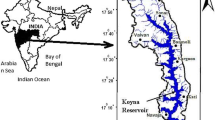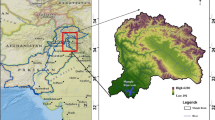In this study, multi-linear regression (MLR) approach is used to construct intermittent reservoir daily inflow forecasting system. To illustrate the applicability and effect of using lumped and distributed input data in MLR approach, Koyna river watershed in Maharashtra, India is chosen as a case study. The results are also compared with autoregressive integrated moving average (ARIMA) models. MLR attempts to model the relationship between two or more independent variables over a dependent variable by fitting a linear regression equation. The main aim of the present study is to see the consequences of development and applicability of simple models, when sufficient data length is available. Out of 47 years of daily historical rainfall and reservoir inflow data, 33 years of data is used for building the model and 14 years of data is used for validating the model. Based on the observed daily rainfall and reservoir inflow, various types of time-series, cause-effect and combined models are developed using lumped and distributed input data. Model performance was evaluated using various performance criteria and it was found that as in the present case, of well correlated input data, both lumped and distributed MLR models perform equally well. For the present case study considered, both MLR and ARIMA models performed equally sound due to availability of large dataset.
Similar content being viewed by others
References
Ahmed J and Sarma A K 2007 Artificial neural network model for synthetic streamflow generation; Water Resour. Mgmt. 21(6) 1015–1029.
Akaike H 1974 A new look at the statistical model identification; IEEE transaction on Automatic Control AC-19(6) 716–723.
Aqil M, Kita I, Yano A and Nishiyama S 2007 A comparative study of artificial neural networks and neuro-fuzzy in continuous modeling of the daily and hourly behaviour of runoff; J. Hydrol. 337(1–2) 22–34.
Aytek A and Alp M 2008 An application of artificial intelligence for rainfall-runoff modelling; J. Earth Syst. Sci. 117(2) 145–155.
Beven K J 2000 Rainfall Runoff Modeling: The Primer; John Wiley & Sons Ltd., Chichester, U.K.
Box G E P and Jenkins G M 1976 Time series analysis forecasting and control; 2nd edn, Holden-Day, San Francisco.
Burlando P, Rosso R, Cadavid L G and Salas J D 1993 Forecasting of short-term rainfall using ARMA models; J. Hydrol. 144(1–4) 193–211.
Campolo M, Andreussi P and Soldati A 1999 River flood forecasting with neural network model; Water Resour. Res. 35(4) 1191–1197.
CDO 1992 Final Report on Revised Flood Study for Koyna Dam, Government of Maharashtra, Irrigation Department.
Chau K W, Wu C L and Li Y S 2005 Comparison of several flood forecasting models in Yangtze River; J. Hydrol. Eng. ASCE 10(6) 485–491.
Chiew F H S, Stewardson M J and McMahon T A 1993 Comparison of six rainfall-runoff modeling approaches; J. Hydrol. 147(1–4) 1–36.
Diskin M H 1970 Definition and uses of the linear regression model; Water Resour. Res. 6(6) 1668–1673.
Driver N E and Troutman B M 1989 Regression models for estimating urban storm-runoff quantity and quality in the US; J. Hydrol. 109(3–4) 221–236.
Hirsch R M 1979 An evaluation on record reconstruction techniques; Water Resour. Res. 15(6) 1781–1790.
Hirsch R M and Gilroy E J 1984 Methods of fitting a straight line data: Examples in water resources; Water Resour. Bullet. 20(5) 705–711.
Hsu K L, Gupta H V and Sorooshian S 1995 Artificial neural network modeling of the rainfall-runoff process; Water Resour. Res. 31(10) 2517–2530.
Jagdeesh A, Zhang B and Govindraju R S 2000 Comparison of ANNs and empirical approaches for predicting watershed runoff; J. Water Resour. Plann. Mgmt. ASCE 126(3) 156–166.
Jain A and Prasad S K V 2003 Comparative analysis of event based rainfall modeling techniques – Deterministic, statistical and Artificial Neural Network; J. Hydrol. Eng. ASCE 8(2) 93–98.
Jothiprakash V and Magar R 2009 Soft computing tools in rainfall-runoff modelling; ISH J. Hydraul. Eng. 15(SP-1) 84–96.
Jothiprakash V, Magar R and Sunil K 2007 Rainfall-runoff modeling using Linear Regression – A case study of an intermittent river; J. Indian Assoc. Env. Mgmt. 34(3) 125–131.
Kisi O 2007 Stream flow forecasting using different artificial neural network algorithms; J. Hydrol. Eng. ASCE 12(5) 532–539.
Loague K M and Freeze R A 1985 A comparison of rainfall-runoff modelling techniques of small upland catchments; Water Resour. Res. 21(2) 229–248.
Luk K C, Ball J E and Sharma A 2000 A study of optimal model lag and spatial inputs to artificial neural network for rainfall forecasting; J. Hydrol. 227(1–4) 56–65.
Maier H R and Dandy G C 1997 Determining inputs for neural network models of multivariate time series; Microcomput. Civil Eng. 12(5) 353–368.
Mays L W and Tung Y 1992 Hydro-systems Engineering and Management, McGraw-Hill Inc, USA.
Momani M and Naill P E 2009 Time series model for rainfall data in Jordan: Case study for using time series analysis; American J. Env. Sci. 5(5) 599–604.
Nash J E and Sutcliffe J V 1970 River flow forecasting through conceptual models, part I – a discussion of principle; J. Hydrol. 10(3) 282–290.
Raman H, Mohan S and Padalianathan 1995 Models for extending stream flow: A case study; Hydrol. Sci. J. 40 381–393.
Rissanen J 1978 Modeling of short data description; Automation 14 465–471.
Salas J D, Delleur V, Yevjevich V and Lane W L 1980 Applied Modeling of Hydrologic Time Series; Water Resour. Publication, CA.
Singh V P 1988 Hydrologic Systems, Vol 1: Rainfall-runoff modeling; Prentice Hall, NJ.
Sivakumar B, Jayawardena A W and Fernando T M G H 2002 River flow forecasting: Use of phase-space reconstruction and artificial neural networks approaches; J. Hydrol. 265(1–4) 225–245.
Sorooshian S, Duan Q and Gupta V K 1993 Calibration of rainfall-runoff models: Application of global optimization to the Sacramento Soil Moisture Accounting model; Water Resour. Res. 29(4) 1185–1194.
Srinivasulu S and Jain A 2006 A comparative analysis of training methods for artificial neural network rainfall runoff models; Applied Soft Compt. 6(3) 295–306.
Sudheer K P, Gosain A K and Ramasastri K S 2002 A data driven algorithm for constructing artificial neural network rainfall-runoff models; Hydrol. Process. 16(6) 1325– 1330.
Sveinsson O G B, Lall U, Fortin V, Perrault L, Gaudet J, Zebiak S and Kushnir Y 2008 Forecasting spring reservoir inflows in Churchill falls basin in Quebec, Canada; J. Hydrol. Eng. ASCE 13(6) 426–437.
Thirumalaiah K and Deo M C 2000 Hydrological forecasting using neural networks; J. Hydrol Eng. ASCE 5(2) 180–189.
Toth E, Brath and Montanari A 2000 Comparison of short-term rainfall prediction models for real-time flood forecasting; J. Hydrol. 239(1–4) 132–147.
Yevjevich V M 1963 Fluctuations of wet and dry years: Part 1 – research data assembly and mathematical models; Coarado State University, Hydrology Paper No. 1.
Author information
Authors and Affiliations
Corresponding author
Rights and permissions
About this article
Cite this article
MAGAR, R.B., JOTHIPRAKASH, V. Intermittent reservoir daily-inflow prediction using lumped and distributed data multi-linear regression models. J Earth Syst Sci 120, 1067–1084 (2011). https://doi.org/10.1007/s12040-011-0127-9
Received:
Revised:
Accepted:
Published:
Issue Date:
DOI: https://doi.org/10.1007/s12040-011-0127-9




